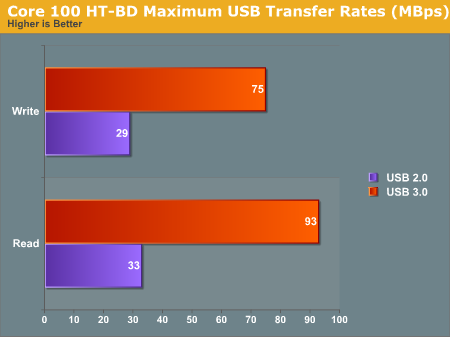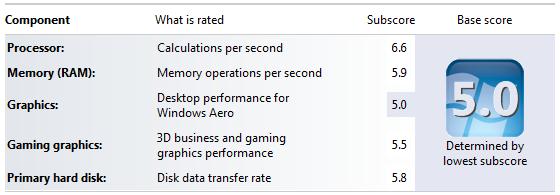ASRock Core 100HT-BD : Bringing HTPCs to the Mainstream Market [UPDATED : Noise Issue]
by Ganesh T S on July 19, 2010 9:34 PM EST- Posted in
- Home Theater
- Arrandale
- ASRock
- Media Streamer
- Core i3
- HTPC
Do the usual benchmarks really provide us with a proper indicator of the worthiness of a HTPC? Is that the performance seen by an average user in real life situations? Such questions often crossed my mind when I looked up the reviews of PCs on various websites. It is almost blasphemous if one were to suggest that the 'Windows Experience Index' is a reflection of what the average user sees. Such a synthetic benchmark might not be a true reflection of the capabilities of the system, but it at least gives an idea to the users as to how much better the system would be compared to the one they currently possess. HTPCs require a different set of performance measurement tests, and we will handle them in the next set of sections. In this, however, we will talk about the general performance metrics in brief.
For readers wanting a lowdown on the core performance aspect (in other words, graphs for various standardized benchmarks) of the motherboard used in this PC, I would suggest reviews from Legion Hardware and Benchmark Reviews. We found nothing in our experiments to dispute their findings. However, one important aspect we would like to cover here is the USB 3.0 performance.
USB 3.0 on the HM55 Chipset
We hooked up OCZ's Enyo 128 GB USB 3.0 external SSD (which has received glowing reviews everywhere with upto 200 MBps read and 190 MBps write speeds) to the front USB 3.0 ports of the Core 100 HT-BD. Contrary to our expectations, we managed to get a maximum of only 93 MBps read and 75 MBps write performance out of the drive. Connecting the same SSD to an USB 2.0 port resulted in a maximum of 33 MBps reads and 29 MBps writes, in line with expectations. We do not get the fabled 10x, but only a 2.7x, improvement over USB 2.0 with the Core 100 HT-BD's USB 3.0 implementation.

A little more analysis revealed that the HM55 chipset does not support PCI-E v2 fully and the bandwidth is limited by the chipset. To get around this limitation, ASRock could have placed a PLX bridge chip on board. We covered this workaround in detail in an earlier piece, but it doesn't make sense for ASRock to implement it in this product. The existing limitation will not be of concern to most users, as SSDs are yet to go mainstream (because of their cost). Most external hard disks with USB 3.0 or eSATA interfaces are inherently limited by the disk-to-buffer transfer rate of around 70 - 90 MBps, and ASRock's USB 3.0 implementation is capable of handling such bandwidth.
Windows Experience Index
A quick glance through the specifications of the system easily reveals the bottleneck affecting the score on the Windows Experience Index. It is none other than Intel's integrated GPU which ends up being the culprit. A screenshot of the Windows Experience Index shows the system chiming in at 5.0. However, we have seen the scores oscillate between 4.4 and 5.2 depending on the graphics driver version, as well as the GPU overclocking status.

Of particular interest is the impressive score received by the processor (6.6), indicating that the performance of this unit would be more than enough for most, if not all, HTPC applications.
DPC Latency Check
Another important criterion for HTPCs is the ability of the system to handle real time streaming of audio and video without dropouts. A handy tool called the DPC Latency Checker helps in analyzing this. This tool was run multiple times in various HTPC scenarios. We did observe red spikes, but disabling the C-states, as well as SpeedStep in the BIOS Advanced CPU configuration helped in alleviating the issue. However, we did not observe any dropouts or playback issues with Blu-Ray or any other media despite the sporadic occurrence of these spikes.
Miscellaneous Performance Indices
Pre-built HTPCs available today are mostly based on the ION chipset, and any comparative evaluation of the benchmark results of this system with ION systems would be grossly unfair for the ION. Both Benchmark Reviews and Legion Hardware compared the Core 100 HT with the ION 330, the 2009 HTPC model from ASRock. Comparing the performance of the Atom to the Core i3 is like comparing apples to oranges, but, for the record, the Core 100 HT system came out better on almost all counts except for the 3D and gaming performance.
On the memory bandwidth side, the Core 100 has more than 2x the performance of the ION 330. CPU performance is around 4 - 5x better. While games appeared to achieve almost similar frame rates on both the Core 100 and the ION 330, 3D performance in applications such as Maya went down by a factor of 2x in favour of the ION 330. Thankfully, applications such as video encoding (a common overnight task for most HTPCs) see a 3.5x performance improvement in the Core 100HT-BD.
In the next section, we will look at the integrated GPU of the Core i3-330M in detail.










107 Comments
View All Comments
ganeshts - Thursday, July 29, 2010 - link
Decaff,I will do more research on how to perfect the picture quality testing metrics.
For your second point, we do have a HTPC software article coming up (end of August) :)
Third, we just posted a review of the WDTV Live. Reviews of other boxes are coming up :)
BSalita - Saturday, July 31, 2010 - link
I congratulate Anandtech for holding out a comprehensive HTPC suite to quantify the performance of new gear. The industry has been lax in creating a consensus of how to properly test HTPC gear. I hope other review sites will likewise use this kind of test suite. Let the media server wanabees know what their systems must do to find a minimal level of acceptability. Only by holding out such a thorough test will we finally have the means for raising out of the quagmire of incomplete codecs, firmware and lightweight product comparisons.Hrel - Sunday, August 15, 2010 - link
1. No tv tuner2. No gaming
3. 700+ dollars?!
I agree with everyone else. I really see no appeal in this system. Something without a tv tuner and that doesn't function as a gaming system will never be worth more than 200, maybe 300 if the features were really nice.
I don't understand why people can't just use their laptops/desktops? I use my desktop on a 37" HDTV. Gaming, video encoding, internet browsing, torrenting, youtube, hulu, DVR, 2TB of storage internally in RAID!!!! Seriously, it's baffling why anyone would accept less when you simply don't have to.
vanderwijk - Monday, August 23, 2010 - link
I was very surprised to read that because HDMI port on the unit is 1.3a the maximum resolution is only 1920 x 1080. This would mean that my Dell 2408 would not be supported because its resolution is 1920 x 1200 :(A quick check on WikiPedia shows that HDMI 1.3a is capable of at least 1920 x 1200, so what's the deal here? Is this an error in the review or is it really not possible to display more than 1080 vertical pixels?
blacksun1234 - Wednesday, August 25, 2010 - link
Yes, it can support 1920x1200.blacksun1234 - Friday, September 3, 2010 - link
Dear Ganesh,Can it support BD 3D playback with Samsung 3D LED TV?
mega999 - Sunday, January 16, 2011 - link
Can it support BD 3D playback with Samsung 3D LED TV? -or do I need the new asrock visiond 3d one for that because of it's hdmi 1.4?Regards,
mega